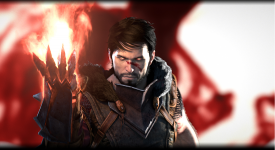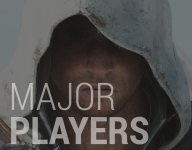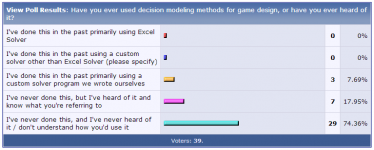LordCrash
Gesperrt
- Mitglied seit
- 16.04.2004
- Beiträge
- 9.599
- Reaktionspunkte
- 1.173
Brian Fargo On InXile’s Darkest, Publisher-Driven Days
By Nathan Grayson on August 15th, 2013

The future is looking very bright for Wasteland 2 and Torment: Tides of Numenera developer inXile. Very bright indeed. Two wildly successful Kickstarters and one nearly complete, maddeningly exciting game later, Brian Fargo and co have finally found their niche. Or rather, they’ve settled back into the comforting clockwork of an old wheelhouse, an old home. But the road to this point was hardly an easy one. The developer-publisher relationship has always been rather skewed, and inXile’s taken its fair share of licks. Some times have been good (see: The Bard’s Tale), and others, well, others have been Hunted: The Demon’s Forge. The latter, especially, is a sore spot for Fargo, but he’s been burned by various publishing arrangements far more than once. He and I discussed that subject, whether Kickstarter is inXile’s permanent solution to that problem, and tons more after I saw Wasteland 2. It’s all below.
RPS: Working with publishers has been kind of a bumpy ride for inXile. On one hand, you got to do Bard’s Tale, but then you also ended up doing things like porting Line Rider, having big projects canceled, and, er, developing a party game. That’s basically the opposite of a sprawling, sophisticated PC RPG.
Fargo: It’s like in all businesses, when you start them. The beginning is what you have to do. You work your way up to what you want to do. I always wanted to make role-playing games, but it was impossible until now. With Bard’s Tale, it had to be consoles. I could not get a deal unless it was console-oriented. And then, whether it was Line Rider or Fantastic Contraption, that was just me seeing talent or seeing products I thought would sell. We’ve done very well with them. But I was struggling to find a business model to allow us to make these kinds of games.
It’s easy to look back and say, “Brian, you should have just gone from Interplay and done role-playing games. What an obvious thing for you to do.” It wasn’t there. When I would talk to publishers, because there was no other way to get the money, I never got to the part where they said, “How much?” They had no interest at any price. There were no options. Once I saw Kickstarter, I said, “This is it. Here’s our chance.”

RPS: How long had you had the idea to do a Wasteland 2 before you finally could do it?
Fargo: 2002. Well, when did I get the mark? 2004. I take that back. 2004. But I’d wanted to do something with it. It was one of the first marks that I got. I thought it was going to be an easy pitch, especially because I had it, and then I was trying to get things going, but then Fallout 3 came out from Bethesda and sold like five million copies. Okay. This is fantastic. I executive produced Wasteland and Fallout. I got one of the designers from Fallout, Jason Anderson, working here. And I had Mike Stackpole, one of the original designers of Wasteland. I have the perfect pitch. I thought, based upon Bethesda’s success, that it would be easy. Nope. No way.
RPS: They’re very different sorts of games at this point.
Fargo: Yeah. They are different. But here’s the best part. As painful as it was [to be turned down so much], I’m glad it never happened any other way. The game we’re making now, that’s the game I wanted to make. I don’t know that, if it had been financed a different way, or with a partner along the way, that I’d be able to do it the way that I’m doing now. It was the best thing for the product.
There was a keynote at GDC Shanghai at the end of 2011. It was about the death of the narrative role-playing game. I would go to Singapore and China and they’d say, “What about Bard’s Tale? What about Wasteland?” I’d always get asked about it. It was all about free-to-play and where that market was going. It’s hard to do a narrative when I’m focusing every bit of my effort on how to get money out of your pocket. It’s a different kind of experience. So it was all about how it was kind of sad that I didn’t see how those games could be made anymore. It was not even six months later that we had the Kickstarter.
RPS: How has the unpredictability of publisher-driven development affected your company? How much has it grown and shrank? It sounds like things weren’t looking so great for you guys before Kickstarter.
Fargo: We used to have more than 60 people. I had to mothball it down to about 15. Again, it’s been trying to find a business model that works, something that’s repeatable. Being a developer is very difficult, because you don’t know what comes next, what you’re going to be working on. The all-or-nothing strategies.
RPS: When you had to cut it down to that size, did you think you were in danger of just having to call it quits on the whole thing?
Fargo: I always had revenue coming in from Bard’s Tale and Line Rider and Choplifter. I’m kind of a scrappy guy, for making things happen. I wanted to build a business. Ironically, I was going full circle. Interplay was a very similar thing, in that when I first started Interplay, it was, “How do I build a business?” Most of the guys who were making games back then were making money. Somebody who did a Dr. J and Larry Bird, well, it sold about a quarter million units, and if you’re just one guy who did it, he’s doing great. If I have a team of people and I sell a quarter million units, big deal. It was why Interplay became a publisher, ultimately.
When I was doing Bard’s Tale one, two, and three, Wasteland, I wasn’t making much money. I was making nothing. My guys were getting it all. I was making nothing. That was why we became a publisher and started doing Battle Chess and Castles and all those other things. It was changing the paradigm. Here, I could probably sit at home and, through my contacts and ideas, make a nice little living, but it’s not really building a business and doing all this, which is what I love. So it’s come full circle, me figuring out how to do that again.
RPS: It’s interesting that you went from something like Hunted: Demon’s Forge to this. That, to me, felt like an RPG that was all of the… “This needs to be on console, so we have to include elements from shooters and things like that” obligatory pandering.
Fargo: The original pitch for that was to be a dungeon crawl. That was what that game wanted to be. Then it got slowly changed to become more of a shooter. But that’s not my background, so… To me, that was a typical failing, where you have the arguments about what a product should be and everything that goes with it. People don’t know sometimes how little the developer can have input-wise into a product, even if it’s theirs. The opening cinematics weren’t done by us. The voice casting was not done by us. We didn’t get to direct the voices in the game. There are all these things that go on that are just pulled away from the developer, that we had no control over.
Ultimately, the people that control the purse strings are going to control the direction of the product. But yeah, how it came out was very different than what my pitch was.

RPS: When that happened, was it basically devastating?
Fargo: Extremely so. Frustrating. Very frustrating. Because ultimately… It’s like when Obsidian took a hit on their Metacritic and didn’t get their bonus. Mostly they got dinged because it was a buggy product. Obsidian, their reputation was taking a hit for shipping buggy products. They don’t control QA. The publisher controls it. The publisher always controls QA. They decide when it’s done. There’s no bug we can’t fix. There’s no bug they can’t fix. Somebody made a conscious decision – because there was a list. I guarantee you the QA department had a list of bugs. They said, “We don’t care. We gotta ship it anyway.” Why does the developer lose their bonus and get their reputation killed for that?
So yeah, you can imagine – even if it’s a different scenario – how it can be frustrating to be a developer doing work when you’re the one that’s taking it every which way. You’re usually not making money, either. I would run the numbers on games and say, “Look. You guys are up $20 million in profit. It’s my idea. I came to you. I did 100 percent of the work. And guess what? I don’t mind if you make more money than me. That doesn’t bother me, because you took the financial risk. However, when you’re up $20 million after paying your marketing and everything, don’t you think we deserve $1 million?” Nope. So yes, it’s frustrating.
RPS: So then you inevitably have to lay off a bunch of your friends and co-workers because there’s no longer enough to go around.
Fargo: Yeah. Every dollar they give you, typically… There’s always some deals that change. I’m sure the guys working on Titanfall have a different deal, so put that on the side. But most developers have a certain kind of deal. It’s all in advance. If a publisher says… Let’s say they slow you down and you have to spend another six months on the project and your team is burning half the money in a month. That’s $3 million of your money. You’re in the hole another $3 million, because everything is in advance.
It also hurts on the creativity, because let’s say you think, “God, I have a great idea. Let’s do it.” And it takes two more weeks to do it. Now you’re in the hole another $150,000 for doing it. It’s counter to coming up with clever ideas. It’s almost like you saying, “Oh, I have a great idea, but you know what? I have to add some more money on to my mortgage.” You’re not going to be as inclined to come up with creative ideas, because you’re never getting out of that hole. You’re digging it deeper. That’s why you have… Usually the owner of the company is spending very little of his time on the project, which you’d like him to spend. Instead he’s thinking, “What are we going to do next? We’re probably not going to recoup and I don’t want to let people with families lose their jobs.”
RPS: With that looming specter of joblessness, too, I think you end up risking not letting the team establish a rapport. If someone comes into a company with the knowledge that after the project’s done, they’ll probably be out, then they can’t get comfortable. They never end up feeling like part of something bigger.
Fargo: And they’re looking for jobs as a result. What you’re going to have is, towards the end of the project you’ll have people leave. You’ll have people leave with two months to go. They’re saying, “Brian, do I have a job afterward? What’s the deal?” I’m not gonna lie. I’m gonna say, “I don’t know. My publisher wants to see how well the product does.” That’s not very much reassurance for a guy who has a wife and kids. You have that even further on top of it.
That’s why this is wonderful here. Everybody knows that we’ve been pre-funded. Any units we ship will be profit. Also, I have Torment. I don’t assume that… We may sell 10,000 units or a million units. I don’t know. I don’t count on that. We don’t know where the production is going to roll. So most of these people you see – Matt and Chris and them – they’ve all been here for 10 years.

RPS: How big is inXile now?
Fargo: A little more than 20 now.
RPS: How big had it blown up to during Hunted and things like that?
Fargo: More than 60.
RPS: So that’s when it hit more than 60. Then you just had to let most of those people go.
Fargo: Yeah. We had to reinvent ourselves. If you’re not doing a big triple-A game, you can’t have 60 people. You just can’t do it. It’s so hard to make money doing the triple-A business. So hard.
RPS: Yeah. You see it more and more right now. People who have been triple-A for decades, even, going indie. I know that there’s been… Not an exodus, but a number of people leaving 2K Marin now that The Bureau is wrapping up. They’re all going off and just doing little indie projects, because it’s finally viable.
Fargo: Right. It’s more satisfying. You feel closer to the sales part of it, too. You think, “If I can make this do 50,000 units…”
RPS: Then you’re golden.
Fargo: Yeah, you’re golden. These times, they are a-changin’.
RPS: Do you think that, as a company, for whatever the next thing is once you’re done with Wasteland and you’re on Torment, will Kickstarter crowdfunding be where you go for that too? No more publishers?
Fargo: I don’t see why we wouldn’t stay with it. You can look at it from a persepective of… Obviously it would only be predicated on us delivering a Wasteland that everybody loves. Now we’ve delivered a game, and they did it. To go back again, you could look at it from one perspective of, “Hey, that way we can get the game cheaper than if we bought it at the final price.” But there’s this whole dialogue and this whole vetting of the idea. If I want to go do something, well, maybe it’s a good idea and maybe it’s not. To me, it ferrets out all these different issues. It opens up a dialogue that we love. I think it’s a great way of doing business. I couldn’t see stopping it.

RPS: What about your history, though? Do you think you’ll keep revisiting aspects of it? What about Bard’s Tale, for instance?
Fargo: I hate to comment on what we’re going to do next, because we have a lot of different ideas, but I’d be more likely to do something more for my core audience than I would to do something off-kilter. We have our niche. It’s role-playing games. One guy’s going to have a niche for train simulators. I think we’re all going to have our different niches. I feel like I know what this audience loves. I’m good at delivering it. So I’m more likely to stay in that wheelhouse.
Comedy [ala the most recent Bard's Tale] is tough, though. I just find that with humor, everybody has an opinion on it. We were going to do a Bard’s Tale 2 Disney, actually. Kind of a funny story. They loved Bard’s Tale, right? So we had this letter of intent in place. We delivered a script. And then somebody on their team, who was an accountant, said, “This isn’t funny.” It was only a first draft. We were going to make a thousand iterations over the next year and a half. It was just to get going. “Well, it’s not funny.” So I was talking to one of the executives there and I said, “Okay. We think it’s funny. She didn’t think it’s funny. We have just shipped a game that we wrote, Bard’s Tale, that people said is the funniest game of all time. So being that we’re like this, wouldn’t you give us the nod? Wouldn’t you think that maybe we had it? You know, the accountant, she hasn’t done this before.” Nope. Killed us. For that and for some other reasons. But it wasn’t funny [laughs].
RPS: Hah. But also awwww. Thank you for your time. It was, um, a lot. Extremely kind of you.
Quelle: Brian Fargo On InXile’s Darkest, Publisher-Driven Days | Rock, Paper, Shotgun
By Nathan Grayson on August 15th, 2013

The future is looking very bright for Wasteland 2 and Torment: Tides of Numenera developer inXile. Very bright indeed. Two wildly successful Kickstarters and one nearly complete, maddeningly exciting game later, Brian Fargo and co have finally found their niche. Or rather, they’ve settled back into the comforting clockwork of an old wheelhouse, an old home. But the road to this point was hardly an easy one. The developer-publisher relationship has always been rather skewed, and inXile’s taken its fair share of licks. Some times have been good (see: The Bard’s Tale), and others, well, others have been Hunted: The Demon’s Forge. The latter, especially, is a sore spot for Fargo, but he’s been burned by various publishing arrangements far more than once. He and I discussed that subject, whether Kickstarter is inXile’s permanent solution to that problem, and tons more after I saw Wasteland 2. It’s all below.
RPS: Working with publishers has been kind of a bumpy ride for inXile. On one hand, you got to do Bard’s Tale, but then you also ended up doing things like porting Line Rider, having big projects canceled, and, er, developing a party game. That’s basically the opposite of a sprawling, sophisticated PC RPG.
Fargo: It’s like in all businesses, when you start them. The beginning is what you have to do. You work your way up to what you want to do. I always wanted to make role-playing games, but it was impossible until now. With Bard’s Tale, it had to be consoles. I could not get a deal unless it was console-oriented. And then, whether it was Line Rider or Fantastic Contraption, that was just me seeing talent or seeing products I thought would sell. We’ve done very well with them. But I was struggling to find a business model to allow us to make these kinds of games.
It’s easy to look back and say, “Brian, you should have just gone from Interplay and done role-playing games. What an obvious thing for you to do.” It wasn’t there. When I would talk to publishers, because there was no other way to get the money, I never got to the part where they said, “How much?” They had no interest at any price. There were no options. Once I saw Kickstarter, I said, “This is it. Here’s our chance.”

RPS: How long had you had the idea to do a Wasteland 2 before you finally could do it?
Fargo: 2002. Well, when did I get the mark? 2004. I take that back. 2004. But I’d wanted to do something with it. It was one of the first marks that I got. I thought it was going to be an easy pitch, especially because I had it, and then I was trying to get things going, but then Fallout 3 came out from Bethesda and sold like five million copies. Okay. This is fantastic. I executive produced Wasteland and Fallout. I got one of the designers from Fallout, Jason Anderson, working here. And I had Mike Stackpole, one of the original designers of Wasteland. I have the perfect pitch. I thought, based upon Bethesda’s success, that it would be easy. Nope. No way.
RPS: They’re very different sorts of games at this point.
Fargo: Yeah. They are different. But here’s the best part. As painful as it was [to be turned down so much], I’m glad it never happened any other way. The game we’re making now, that’s the game I wanted to make. I don’t know that, if it had been financed a different way, or with a partner along the way, that I’d be able to do it the way that I’m doing now. It was the best thing for the product.
There was a keynote at GDC Shanghai at the end of 2011. It was about the death of the narrative role-playing game. I would go to Singapore and China and they’d say, “What about Bard’s Tale? What about Wasteland?” I’d always get asked about it. It was all about free-to-play and where that market was going. It’s hard to do a narrative when I’m focusing every bit of my effort on how to get money out of your pocket. It’s a different kind of experience. So it was all about how it was kind of sad that I didn’t see how those games could be made anymore. It was not even six months later that we had the Kickstarter.
RPS: How has the unpredictability of publisher-driven development affected your company? How much has it grown and shrank? It sounds like things weren’t looking so great for you guys before Kickstarter.
Fargo: We used to have more than 60 people. I had to mothball it down to about 15. Again, it’s been trying to find a business model that works, something that’s repeatable. Being a developer is very difficult, because you don’t know what comes next, what you’re going to be working on. The all-or-nothing strategies.
RPS: When you had to cut it down to that size, did you think you were in danger of just having to call it quits on the whole thing?
Fargo: I always had revenue coming in from Bard’s Tale and Line Rider and Choplifter. I’m kind of a scrappy guy, for making things happen. I wanted to build a business. Ironically, I was going full circle. Interplay was a very similar thing, in that when I first started Interplay, it was, “How do I build a business?” Most of the guys who were making games back then were making money. Somebody who did a Dr. J and Larry Bird, well, it sold about a quarter million units, and if you’re just one guy who did it, he’s doing great. If I have a team of people and I sell a quarter million units, big deal. It was why Interplay became a publisher, ultimately.
When I was doing Bard’s Tale one, two, and three, Wasteland, I wasn’t making much money. I was making nothing. My guys were getting it all. I was making nothing. That was why we became a publisher and started doing Battle Chess and Castles and all those other things. It was changing the paradigm. Here, I could probably sit at home and, through my contacts and ideas, make a nice little living, but it’s not really building a business and doing all this, which is what I love. So it’s come full circle, me figuring out how to do that again.
RPS: It’s interesting that you went from something like Hunted: Demon’s Forge to this. That, to me, felt like an RPG that was all of the… “This needs to be on console, so we have to include elements from shooters and things like that” obligatory pandering.
Fargo: The original pitch for that was to be a dungeon crawl. That was what that game wanted to be. Then it got slowly changed to become more of a shooter. But that’s not my background, so… To me, that was a typical failing, where you have the arguments about what a product should be and everything that goes with it. People don’t know sometimes how little the developer can have input-wise into a product, even if it’s theirs. The opening cinematics weren’t done by us. The voice casting was not done by us. We didn’t get to direct the voices in the game. There are all these things that go on that are just pulled away from the developer, that we had no control over.
Ultimately, the people that control the purse strings are going to control the direction of the product. But yeah, how it came out was very different than what my pitch was.

RPS: When that happened, was it basically devastating?
Fargo: Extremely so. Frustrating. Very frustrating. Because ultimately… It’s like when Obsidian took a hit on their Metacritic and didn’t get their bonus. Mostly they got dinged because it was a buggy product. Obsidian, their reputation was taking a hit for shipping buggy products. They don’t control QA. The publisher controls it. The publisher always controls QA. They decide when it’s done. There’s no bug we can’t fix. There’s no bug they can’t fix. Somebody made a conscious decision – because there was a list. I guarantee you the QA department had a list of bugs. They said, “We don’t care. We gotta ship it anyway.” Why does the developer lose their bonus and get their reputation killed for that?
So yeah, you can imagine – even if it’s a different scenario – how it can be frustrating to be a developer doing work when you’re the one that’s taking it every which way. You’re usually not making money, either. I would run the numbers on games and say, “Look. You guys are up $20 million in profit. It’s my idea. I came to you. I did 100 percent of the work. And guess what? I don’t mind if you make more money than me. That doesn’t bother me, because you took the financial risk. However, when you’re up $20 million after paying your marketing and everything, don’t you think we deserve $1 million?” Nope. So yes, it’s frustrating.
RPS: So then you inevitably have to lay off a bunch of your friends and co-workers because there’s no longer enough to go around.
Fargo: Yeah. Every dollar they give you, typically… There’s always some deals that change. I’m sure the guys working on Titanfall have a different deal, so put that on the side. But most developers have a certain kind of deal. It’s all in advance. If a publisher says… Let’s say they slow you down and you have to spend another six months on the project and your team is burning half the money in a month. That’s $3 million of your money. You’re in the hole another $3 million, because everything is in advance.
It also hurts on the creativity, because let’s say you think, “God, I have a great idea. Let’s do it.” And it takes two more weeks to do it. Now you’re in the hole another $150,000 for doing it. It’s counter to coming up with clever ideas. It’s almost like you saying, “Oh, I have a great idea, but you know what? I have to add some more money on to my mortgage.” You’re not going to be as inclined to come up with creative ideas, because you’re never getting out of that hole. You’re digging it deeper. That’s why you have… Usually the owner of the company is spending very little of his time on the project, which you’d like him to spend. Instead he’s thinking, “What are we going to do next? We’re probably not going to recoup and I don’t want to let people with families lose their jobs.”
RPS: With that looming specter of joblessness, too, I think you end up risking not letting the team establish a rapport. If someone comes into a company with the knowledge that after the project’s done, they’ll probably be out, then they can’t get comfortable. They never end up feeling like part of something bigger.
Fargo: And they’re looking for jobs as a result. What you’re going to have is, towards the end of the project you’ll have people leave. You’ll have people leave with two months to go. They’re saying, “Brian, do I have a job afterward? What’s the deal?” I’m not gonna lie. I’m gonna say, “I don’t know. My publisher wants to see how well the product does.” That’s not very much reassurance for a guy who has a wife and kids. You have that even further on top of it.
That’s why this is wonderful here. Everybody knows that we’ve been pre-funded. Any units we ship will be profit. Also, I have Torment. I don’t assume that… We may sell 10,000 units or a million units. I don’t know. I don’t count on that. We don’t know where the production is going to roll. So most of these people you see – Matt and Chris and them – they’ve all been here for 10 years.

RPS: How big is inXile now?
Fargo: A little more than 20 now.
RPS: How big had it blown up to during Hunted and things like that?
Fargo: More than 60.
RPS: So that’s when it hit more than 60. Then you just had to let most of those people go.
Fargo: Yeah. We had to reinvent ourselves. If you’re not doing a big triple-A game, you can’t have 60 people. You just can’t do it. It’s so hard to make money doing the triple-A business. So hard.
RPS: Yeah. You see it more and more right now. People who have been triple-A for decades, even, going indie. I know that there’s been… Not an exodus, but a number of people leaving 2K Marin now that The Bureau is wrapping up. They’re all going off and just doing little indie projects, because it’s finally viable.
Fargo: Right. It’s more satisfying. You feel closer to the sales part of it, too. You think, “If I can make this do 50,000 units…”
RPS: Then you’re golden.
Fargo: Yeah, you’re golden. These times, they are a-changin’.
RPS: Do you think that, as a company, for whatever the next thing is once you’re done with Wasteland and you’re on Torment, will Kickstarter crowdfunding be where you go for that too? No more publishers?
Fargo: I don’t see why we wouldn’t stay with it. You can look at it from a persepective of… Obviously it would only be predicated on us delivering a Wasteland that everybody loves. Now we’ve delivered a game, and they did it. To go back again, you could look at it from one perspective of, “Hey, that way we can get the game cheaper than if we bought it at the final price.” But there’s this whole dialogue and this whole vetting of the idea. If I want to go do something, well, maybe it’s a good idea and maybe it’s not. To me, it ferrets out all these different issues. It opens up a dialogue that we love. I think it’s a great way of doing business. I couldn’t see stopping it.

RPS: What about your history, though? Do you think you’ll keep revisiting aspects of it? What about Bard’s Tale, for instance?
Fargo: I hate to comment on what we’re going to do next, because we have a lot of different ideas, but I’d be more likely to do something more for my core audience than I would to do something off-kilter. We have our niche. It’s role-playing games. One guy’s going to have a niche for train simulators. I think we’re all going to have our different niches. I feel like I know what this audience loves. I’m good at delivering it. So I’m more likely to stay in that wheelhouse.
Comedy [ala the most recent Bard's Tale] is tough, though. I just find that with humor, everybody has an opinion on it. We were going to do a Bard’s Tale 2 Disney, actually. Kind of a funny story. They loved Bard’s Tale, right? So we had this letter of intent in place. We delivered a script. And then somebody on their team, who was an accountant, said, “This isn’t funny.” It was only a first draft. We were going to make a thousand iterations over the next year and a half. It was just to get going. “Well, it’s not funny.” So I was talking to one of the executives there and I said, “Okay. We think it’s funny. She didn’t think it’s funny. We have just shipped a game that we wrote, Bard’s Tale, that people said is the funniest game of all time. So being that we’re like this, wouldn’t you give us the nod? Wouldn’t you think that maybe we had it? You know, the accountant, she hasn’t done this before.” Nope. Killed us. For that and for some other reasons. But it wasn’t funny [laughs].
RPS: Hah. But also awwww. Thank you for your time. It was, um, a lot. Extremely kind of you.
Quelle: Brian Fargo On InXile’s Darkest, Publisher-Driven Days | Rock, Paper, Shotgun




















![Rimworld 10[4].jpg Rimworld 10[4].jpg](https://forum.pcgames.de/data/attachments/2/2846-d29b07a6d6dcf0f3be073e53803f1b15.jpg)
![Rimworld 9[3].jpg Rimworld 9[3].jpg](https://forum.pcgames.de/data/attachments/2/2847-883c97778a79f1feae21db3d74807c06.jpg)
![Rimworld 6[3].jpg Rimworld 6[3].jpg](https://forum.pcgames.de/data/attachments/2/2848-d17179c4e4639b6936adc8ba88b75d20.jpg)
![Rimworld 5[3].jpg Rimworld 5[3].jpg](https://forum.pcgames.de/data/attachments/2/2849-0ef3a7b0caff52c6d78f5455fddef4f9.jpg)
![Rimworld 2[3].jpg Rimworld 2[3].jpg](https://forum.pcgames.de/data/attachments/2/2850-900af75403c2f22f16a0dd0d324d08e6.jpg)
























